HSN210 Assignment 2: Nutrition Promotion for Child Vegetable Intake
VerifiedAdded on 2022/10/01
|11
|2921
|99
Report
AI Summary
This report presents a comprehensive nutrition promotion plan aimed at increasing vegetable consumption among children aged 9-11, addressing the issue of inadequate vegetable intake in Australia. The plan incorporates the Social Cognitive Theory to understand and influence children's dietary behaviors. It outlines a school-based intervention that includes educational activities like classroom teachings, gardening, and parent-teacher communication, along with increasing vegetable availability in the school canteen. The report analyzes factors influencing healthy food consumption, such as food preferences and knowledge, and discusses strategies for implementation, including teacher training, curriculum integration, and environmental changes. Barriers to implementation, such as curriculum constraints and negative attitudes towards vegetables, are also acknowledged, along with potential solutions. The plan targets supermarkets and food outlets and proposes an evaluation strategy to monitor the program's effectiveness, focusing on improving vegetable intake from 1-3 to 5 serves a day.
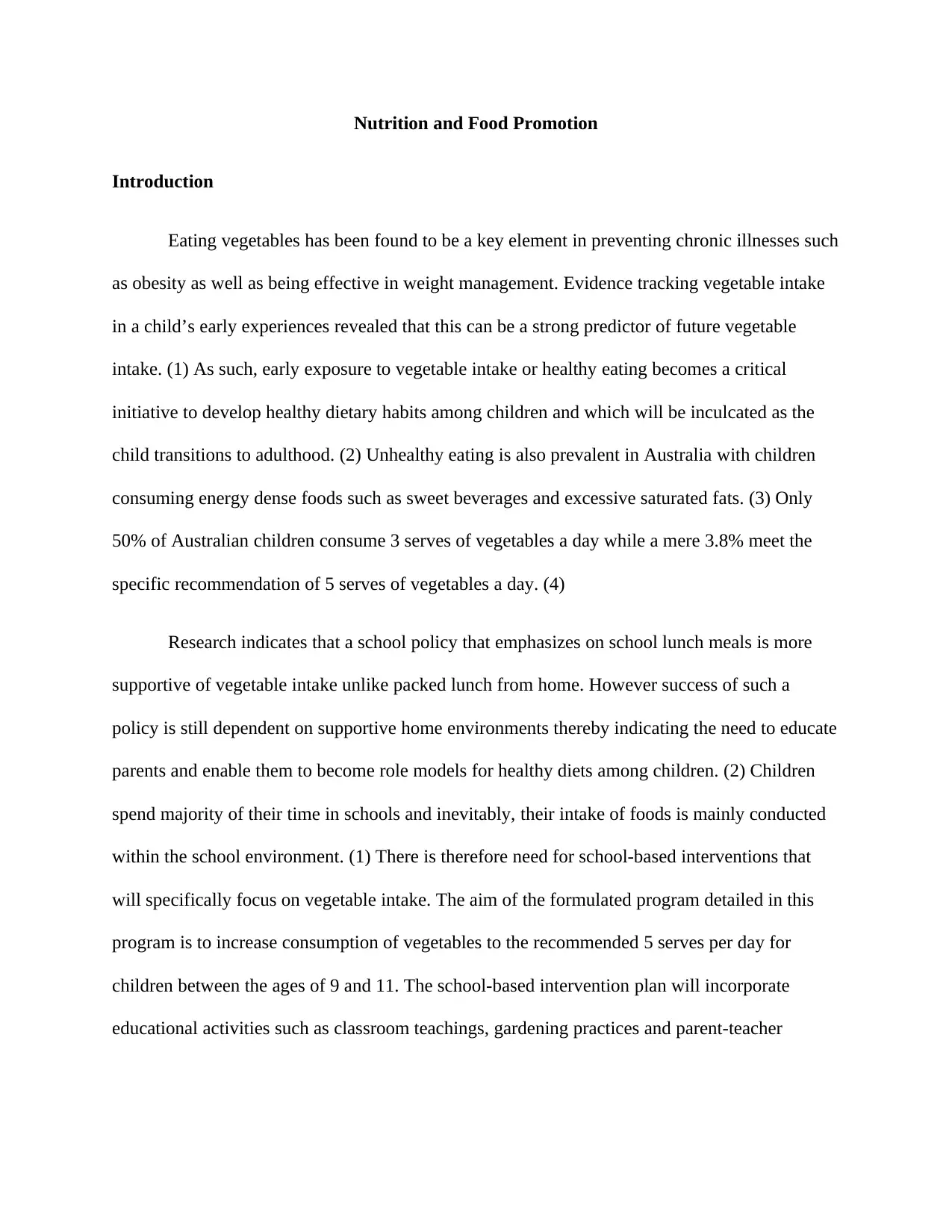
Nutrition and Food Promotion
Introduction
Eating vegetables has been found to be a key element in preventing chronic illnesses such
as obesity as well as being effective in weight management. Evidence tracking vegetable intake
in a child’s early experiences revealed that this can be a strong predictor of future vegetable
intake. (1) As such, early exposure to vegetable intake or healthy eating becomes a critical
initiative to develop healthy dietary habits among children and which will be inculcated as the
child transitions to adulthood. (2) Unhealthy eating is also prevalent in Australia with children
consuming energy dense foods such as sweet beverages and excessive saturated fats. (3) Only
50% of Australian children consume 3 serves of vegetables a day while a mere 3.8% meet the
specific recommendation of 5 serves of vegetables a day. (4)
Research indicates that a school policy that emphasizes on school lunch meals is more
supportive of vegetable intake unlike packed lunch from home. However success of such a
policy is still dependent on supportive home environments thereby indicating the need to educate
parents and enable them to become role models for healthy diets among children. (2) Children
spend majority of their time in schools and inevitably, their intake of foods is mainly conducted
within the school environment. (1) There is therefore need for school-based interventions that
will specifically focus on vegetable intake. The aim of the formulated program detailed in this
program is to increase consumption of vegetables to the recommended 5 serves per day for
children between the ages of 9 and 11. The school-based intervention plan will incorporate
educational activities such as classroom teachings, gardening practices and parent-teacher
Introduction
Eating vegetables has been found to be a key element in preventing chronic illnesses such
as obesity as well as being effective in weight management. Evidence tracking vegetable intake
in a child’s early experiences revealed that this can be a strong predictor of future vegetable
intake. (1) As such, early exposure to vegetable intake or healthy eating becomes a critical
initiative to develop healthy dietary habits among children and which will be inculcated as the
child transitions to adulthood. (2) Unhealthy eating is also prevalent in Australia with children
consuming energy dense foods such as sweet beverages and excessive saturated fats. (3) Only
50% of Australian children consume 3 serves of vegetables a day while a mere 3.8% meet the
specific recommendation of 5 serves of vegetables a day. (4)
Research indicates that a school policy that emphasizes on school lunch meals is more
supportive of vegetable intake unlike packed lunch from home. However success of such a
policy is still dependent on supportive home environments thereby indicating the need to educate
parents and enable them to become role models for healthy diets among children. (2) Children
spend majority of their time in schools and inevitably, their intake of foods is mainly conducted
within the school environment. (1) There is therefore need for school-based interventions that
will specifically focus on vegetable intake. The aim of the formulated program detailed in this
program is to increase consumption of vegetables to the recommended 5 serves per day for
children between the ages of 9 and 11. The school-based intervention plan will incorporate
educational activities such as classroom teachings, gardening practices and parent-teacher
Paraphrase This Document
Need a fresh take? Get an instant paraphrase of this document with our AI Paraphraser
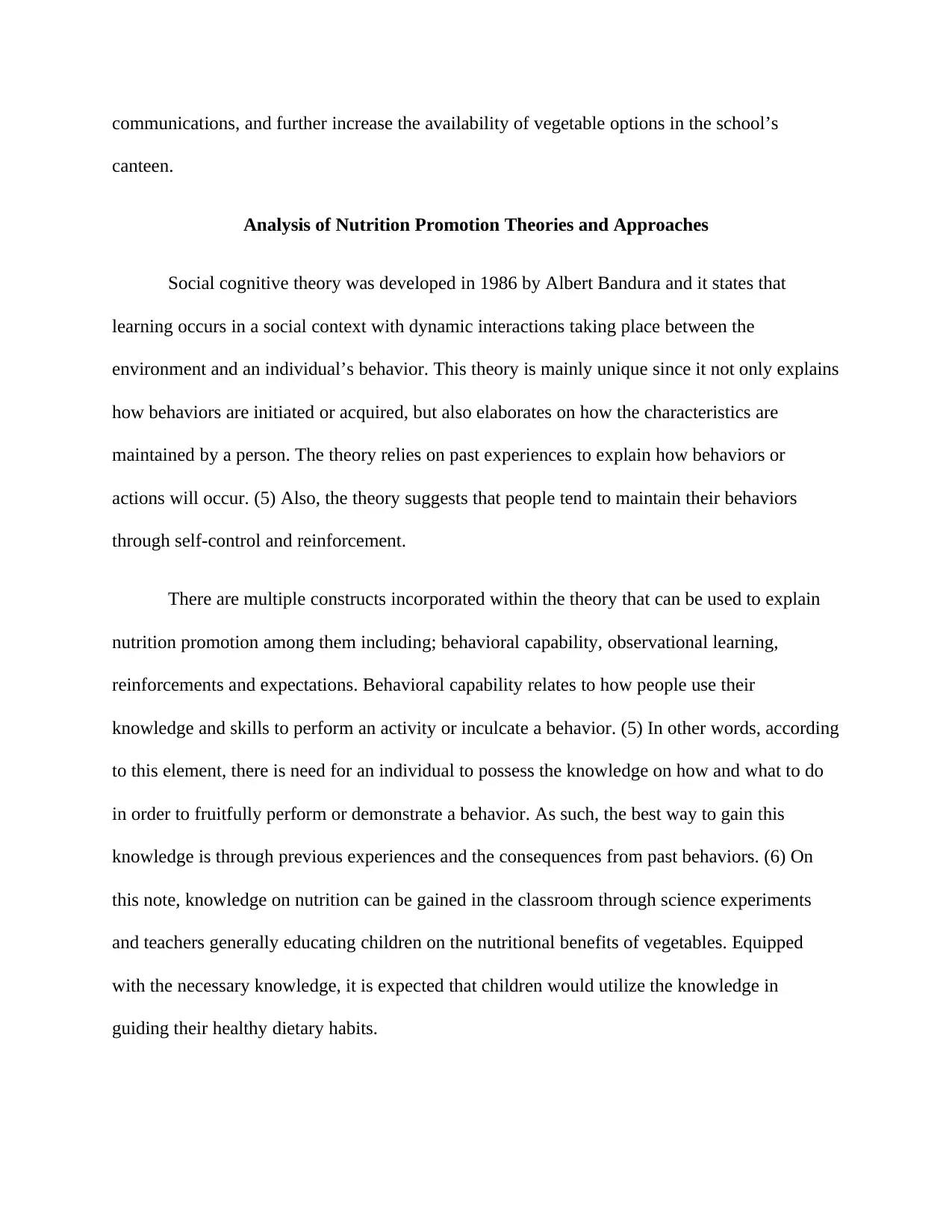
communications, and further increase the availability of vegetable options in the school’s
canteen.
Analysis of Nutrition Promotion Theories and Approaches
Social cognitive theory was developed in 1986 by Albert Bandura and it states that
learning occurs in a social context with dynamic interactions taking place between the
environment and an individual’s behavior. This theory is mainly unique since it not only explains
how behaviors are initiated or acquired, but also elaborates on how the characteristics are
maintained by a person. The theory relies on past experiences to explain how behaviors or
actions will occur. (5) Also, the theory suggests that people tend to maintain their behaviors
through self-control and reinforcement.
There are multiple constructs incorporated within the theory that can be used to explain
nutrition promotion among them including; behavioral capability, observational learning,
reinforcements and expectations. Behavioral capability relates to how people use their
knowledge and skills to perform an activity or inculcate a behavior. (5) In other words, according
to this element, there is need for an individual to possess the knowledge on how and what to do
in order to fruitfully perform or demonstrate a behavior. As such, the best way to gain this
knowledge is through previous experiences and the consequences from past behaviors. (6) On
this note, knowledge on nutrition can be gained in the classroom through science experiments
and teachers generally educating children on the nutritional benefits of vegetables. Equipped
with the necessary knowledge, it is expected that children would utilize the knowledge in
guiding their healthy dietary habits.
canteen.
Analysis of Nutrition Promotion Theories and Approaches
Social cognitive theory was developed in 1986 by Albert Bandura and it states that
learning occurs in a social context with dynamic interactions taking place between the
environment and an individual’s behavior. This theory is mainly unique since it not only explains
how behaviors are initiated or acquired, but also elaborates on how the characteristics are
maintained by a person. The theory relies on past experiences to explain how behaviors or
actions will occur. (5) Also, the theory suggests that people tend to maintain their behaviors
through self-control and reinforcement.
There are multiple constructs incorporated within the theory that can be used to explain
nutrition promotion among them including; behavioral capability, observational learning,
reinforcements and expectations. Behavioral capability relates to how people use their
knowledge and skills to perform an activity or inculcate a behavior. (5) In other words, according
to this element, there is need for an individual to possess the knowledge on how and what to do
in order to fruitfully perform or demonstrate a behavior. As such, the best way to gain this
knowledge is through previous experiences and the consequences from past behaviors. (6) On
this note, knowledge on nutrition can be gained in the classroom through science experiments
and teachers generally educating children on the nutritional benefits of vegetables. Equipped
with the necessary knowledge, it is expected that children would utilize the knowledge in
guiding their healthy dietary habits.
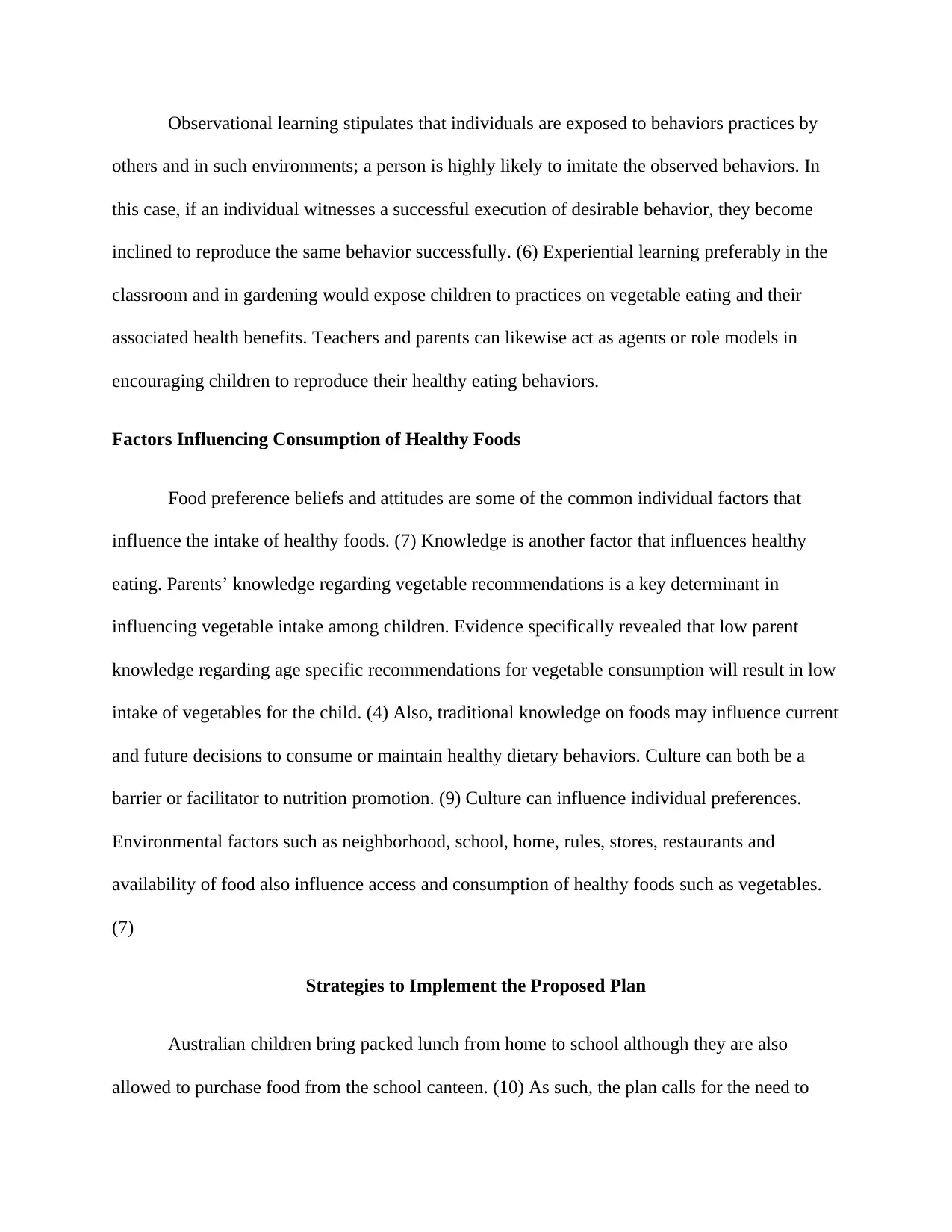
Observational learning stipulates that individuals are exposed to behaviors practices by
others and in such environments; a person is highly likely to imitate the observed behaviors. In
this case, if an individual witnesses a successful execution of desirable behavior, they become
inclined to reproduce the same behavior successfully. (6) Experiential learning preferably in the
classroom and in gardening would expose children to practices on vegetable eating and their
associated health benefits. Teachers and parents can likewise act as agents or role models in
encouraging children to reproduce their healthy eating behaviors.
Factors Influencing Consumption of Healthy Foods
Food preference beliefs and attitudes are some of the common individual factors that
influence the intake of healthy foods. (7) Knowledge is another factor that influences healthy
eating. Parents’ knowledge regarding vegetable recommendations is a key determinant in
influencing vegetable intake among children. Evidence specifically revealed that low parent
knowledge regarding age specific recommendations for vegetable consumption will result in low
intake of vegetables for the child. (4) Also, traditional knowledge on foods may influence current
and future decisions to consume or maintain healthy dietary behaviors. Culture can both be a
barrier or facilitator to nutrition promotion. (9) Culture can influence individual preferences.
Environmental factors such as neighborhood, school, home, rules, stores, restaurants and
availability of food also influence access and consumption of healthy foods such as vegetables.
(7)
Strategies to Implement the Proposed Plan
Australian children bring packed lunch from home to school although they are also
allowed to purchase food from the school canteen. (10) As such, the plan calls for the need to
others and in such environments; a person is highly likely to imitate the observed behaviors. In
this case, if an individual witnesses a successful execution of desirable behavior, they become
inclined to reproduce the same behavior successfully. (6) Experiential learning preferably in the
classroom and in gardening would expose children to practices on vegetable eating and their
associated health benefits. Teachers and parents can likewise act as agents or role models in
encouraging children to reproduce their healthy eating behaviors.
Factors Influencing Consumption of Healthy Foods
Food preference beliefs and attitudes are some of the common individual factors that
influence the intake of healthy foods. (7) Knowledge is another factor that influences healthy
eating. Parents’ knowledge regarding vegetable recommendations is a key determinant in
influencing vegetable intake among children. Evidence specifically revealed that low parent
knowledge regarding age specific recommendations for vegetable consumption will result in low
intake of vegetables for the child. (4) Also, traditional knowledge on foods may influence current
and future decisions to consume or maintain healthy dietary behaviors. Culture can both be a
barrier or facilitator to nutrition promotion. (9) Culture can influence individual preferences.
Environmental factors such as neighborhood, school, home, rules, stores, restaurants and
availability of food also influence access and consumption of healthy foods such as vegetables.
(7)
Strategies to Implement the Proposed Plan
Australian children bring packed lunch from home to school although they are also
allowed to purchase food from the school canteen. (10) As such, the plan calls for the need to
⊘ This is a preview!⊘
Do you want full access?
Subscribe today to unlock all pages.

Trusted by 1+ million students worldwide
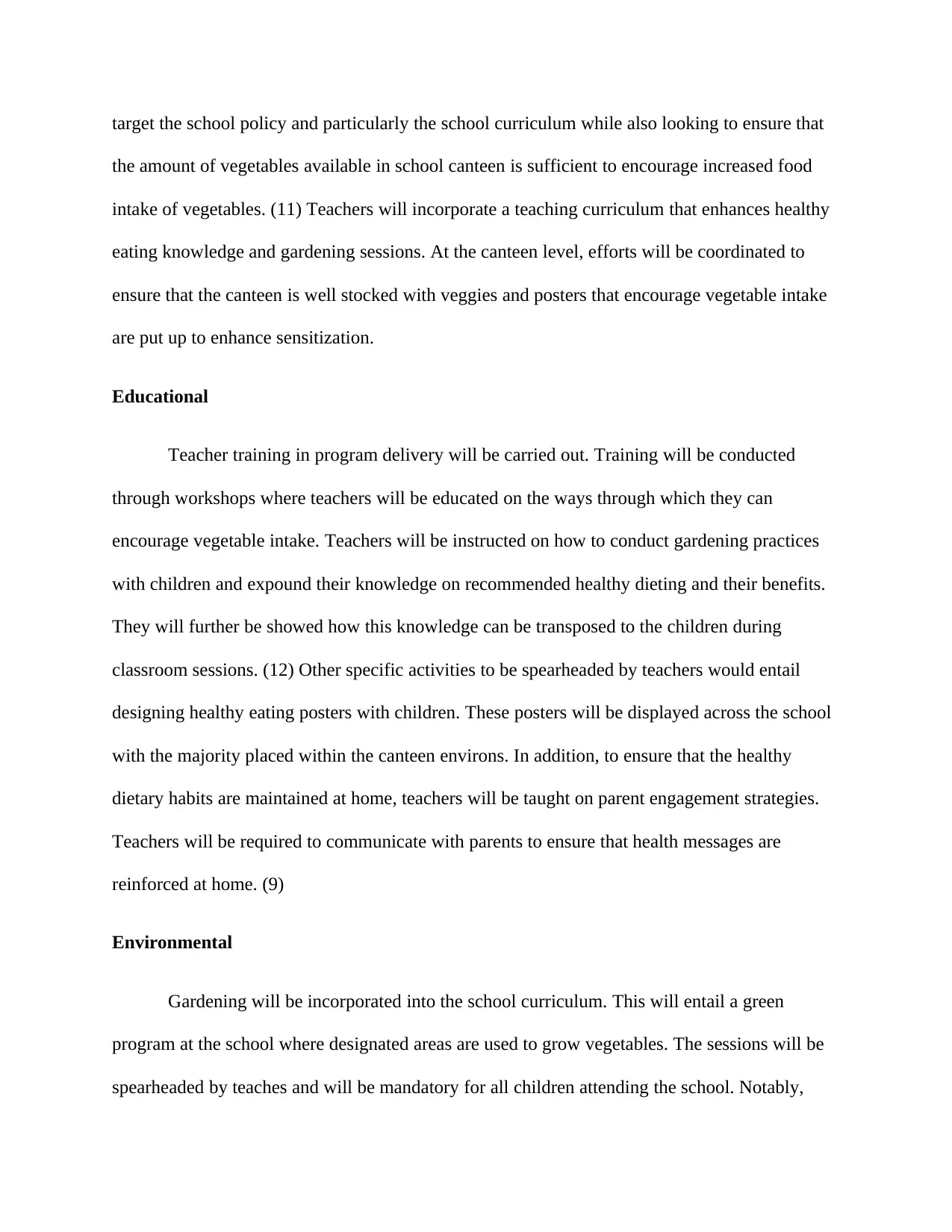
target the school policy and particularly the school curriculum while also looking to ensure that
the amount of vegetables available in school canteen is sufficient to encourage increased food
intake of vegetables. (11) Teachers will incorporate a teaching curriculum that enhances healthy
eating knowledge and gardening sessions. At the canteen level, efforts will be coordinated to
ensure that the canteen is well stocked with veggies and posters that encourage vegetable intake
are put up to enhance sensitization.
Educational
Teacher training in program delivery will be carried out. Training will be conducted
through workshops where teachers will be educated on the ways through which they can
encourage vegetable intake. Teachers will be instructed on how to conduct gardening practices
with children and expound their knowledge on recommended healthy dieting and their benefits.
They will further be showed how this knowledge can be transposed to the children during
classroom sessions. (12) Other specific activities to be spearheaded by teachers would entail
designing healthy eating posters with children. These posters will be displayed across the school
with the majority placed within the canteen environs. In addition, to ensure that the healthy
dietary habits are maintained at home, teachers will be taught on parent engagement strategies.
Teachers will be required to communicate with parents to ensure that health messages are
reinforced at home. (9)
Environmental
Gardening will be incorporated into the school curriculum. This will entail a green
program at the school where designated areas are used to grow vegetables. The sessions will be
spearheaded by teaches and will be mandatory for all children attending the school. Notably,
the amount of vegetables available in school canteen is sufficient to encourage increased food
intake of vegetables. (11) Teachers will incorporate a teaching curriculum that enhances healthy
eating knowledge and gardening sessions. At the canteen level, efforts will be coordinated to
ensure that the canteen is well stocked with veggies and posters that encourage vegetable intake
are put up to enhance sensitization.
Educational
Teacher training in program delivery will be carried out. Training will be conducted
through workshops where teachers will be educated on the ways through which they can
encourage vegetable intake. Teachers will be instructed on how to conduct gardening practices
with children and expound their knowledge on recommended healthy dieting and their benefits.
They will further be showed how this knowledge can be transposed to the children during
classroom sessions. (12) Other specific activities to be spearheaded by teachers would entail
designing healthy eating posters with children. These posters will be displayed across the school
with the majority placed within the canteen environs. In addition, to ensure that the healthy
dietary habits are maintained at home, teachers will be taught on parent engagement strategies.
Teachers will be required to communicate with parents to ensure that health messages are
reinforced at home. (9)
Environmental
Gardening will be incorporated into the school curriculum. This will entail a green
program at the school where designated areas are used to grow vegetables. The sessions will be
spearheaded by teaches and will be mandatory for all children attending the school. Notably,
Paraphrase This Document
Need a fresh take? Get an instant paraphrase of this document with our AI Paraphraser
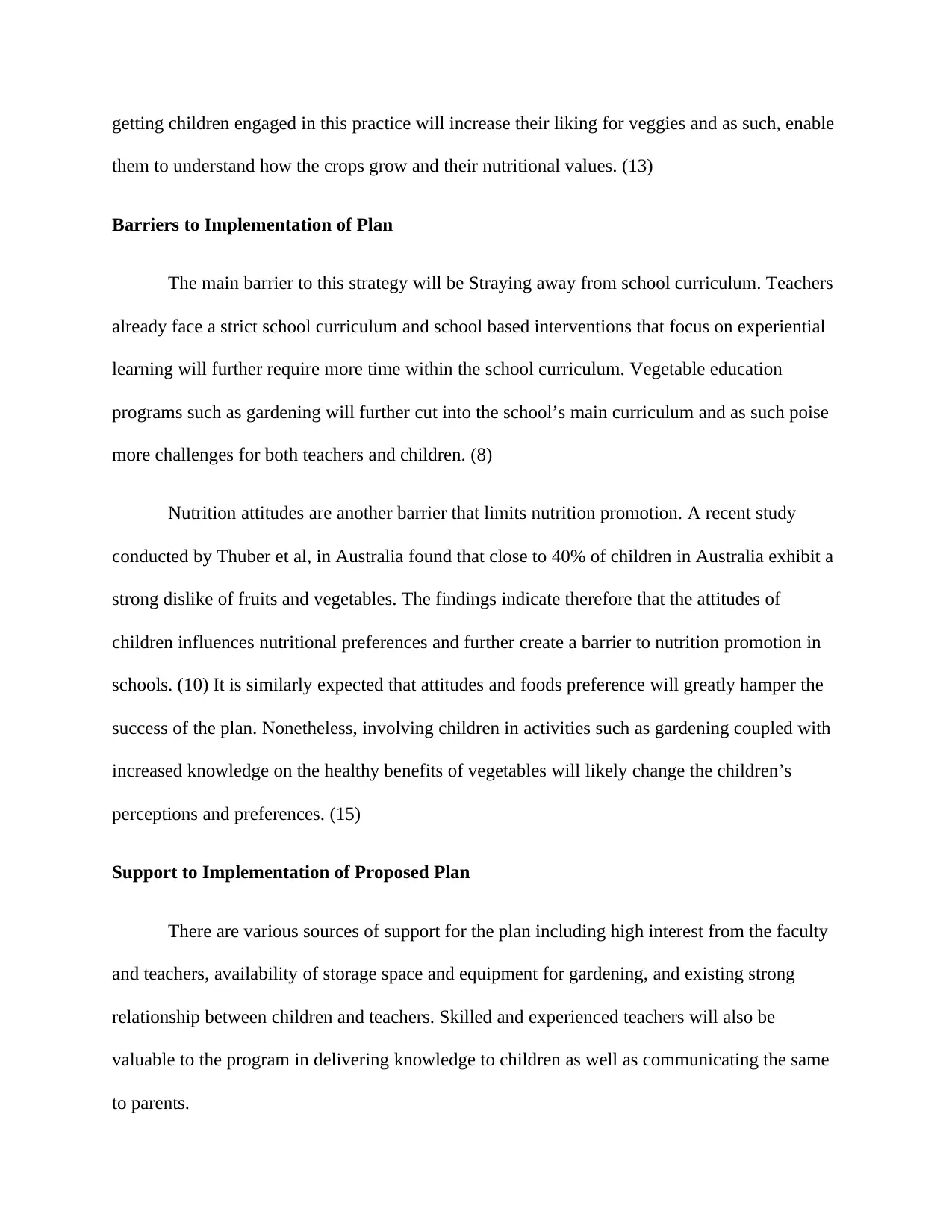
getting children engaged in this practice will increase their liking for veggies and as such, enable
them to understand how the crops grow and their nutritional values. (13)
Barriers to Implementation of Plan
The main barrier to this strategy will be Straying away from school curriculum. Teachers
already face a strict school curriculum and school based interventions that focus on experiential
learning will further require more time within the school curriculum. Vegetable education
programs such as gardening will further cut into the school’s main curriculum and as such poise
more challenges for both teachers and children. (8)
Nutrition attitudes are another barrier that limits nutrition promotion. A recent study
conducted by Thuber et al, in Australia found that close to 40% of children in Australia exhibit a
strong dislike of fruits and vegetables. The findings indicate therefore that the attitudes of
children influences nutritional preferences and further create a barrier to nutrition promotion in
schools. (10) It is similarly expected that attitudes and foods preference will greatly hamper the
success of the plan. Nonetheless, involving children in activities such as gardening coupled with
increased knowledge on the healthy benefits of vegetables will likely change the children’s
perceptions and preferences. (15)
Support to Implementation of Proposed Plan
There are various sources of support for the plan including high interest from the faculty
and teachers, availability of storage space and equipment for gardening, and existing strong
relationship between children and teachers. Skilled and experienced teachers will also be
valuable to the program in delivering knowledge to children as well as communicating the same
to parents.
them to understand how the crops grow and their nutritional values. (13)
Barriers to Implementation of Plan
The main barrier to this strategy will be Straying away from school curriculum. Teachers
already face a strict school curriculum and school based interventions that focus on experiential
learning will further require more time within the school curriculum. Vegetable education
programs such as gardening will further cut into the school’s main curriculum and as such poise
more challenges for both teachers and children. (8)
Nutrition attitudes are another barrier that limits nutrition promotion. A recent study
conducted by Thuber et al, in Australia found that close to 40% of children in Australia exhibit a
strong dislike of fruits and vegetables. The findings indicate therefore that the attitudes of
children influences nutritional preferences and further create a barrier to nutrition promotion in
schools. (10) It is similarly expected that attitudes and foods preference will greatly hamper the
success of the plan. Nonetheless, involving children in activities such as gardening coupled with
increased knowledge on the healthy benefits of vegetables will likely change the children’s
perceptions and preferences. (15)
Support to Implementation of Proposed Plan
There are various sources of support for the plan including high interest from the faculty
and teachers, availability of storage space and equipment for gardening, and existing strong
relationship between children and teachers. Skilled and experienced teachers will also be
valuable to the program in delivering knowledge to children as well as communicating the same
to parents.
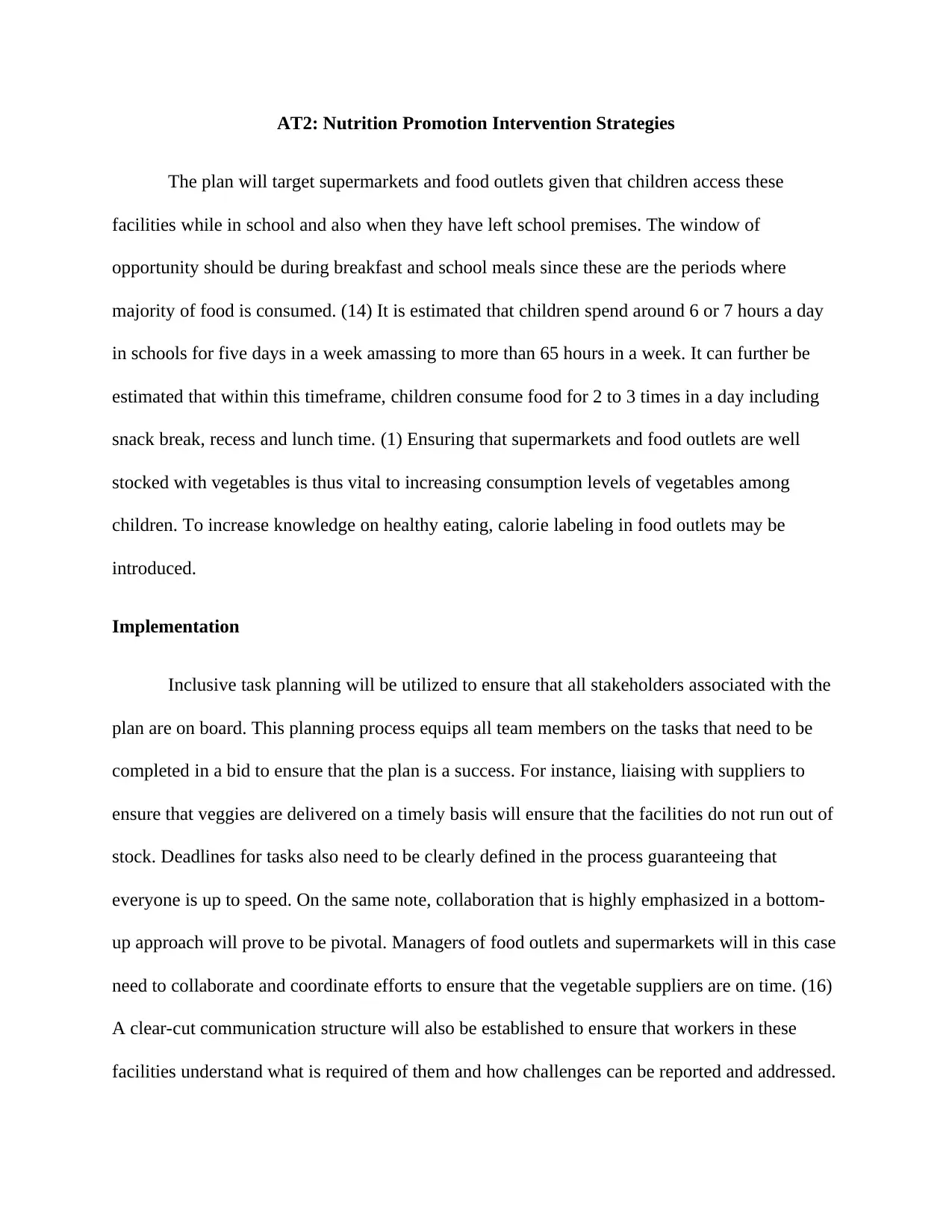
AT2: Nutrition Promotion Intervention Strategies
The plan will target supermarkets and food outlets given that children access these
facilities while in school and also when they have left school premises. The window of
opportunity should be during breakfast and school meals since these are the periods where
majority of food is consumed. (14) It is estimated that children spend around 6 or 7 hours a day
in schools for five days in a week amassing to more than 65 hours in a week. It can further be
estimated that within this timeframe, children consume food for 2 to 3 times in a day including
snack break, recess and lunch time. (1) Ensuring that supermarkets and food outlets are well
stocked with vegetables is thus vital to increasing consumption levels of vegetables among
children. To increase knowledge on healthy eating, calorie labeling in food outlets may be
introduced.
Implementation
Inclusive task planning will be utilized to ensure that all stakeholders associated with the
plan are on board. This planning process equips all team members on the tasks that need to be
completed in a bid to ensure that the plan is a success. For instance, liaising with suppliers to
ensure that veggies are delivered on a timely basis will ensure that the facilities do not run out of
stock. Deadlines for tasks also need to be clearly defined in the process guaranteeing that
everyone is up to speed. On the same note, collaboration that is highly emphasized in a bottom-
up approach will prove to be pivotal. Managers of food outlets and supermarkets will in this case
need to collaborate and coordinate efforts to ensure that the vegetable suppliers are on time. (16)
A clear-cut communication structure will also be established to ensure that workers in these
facilities understand what is required of them and how challenges can be reported and addressed.
The plan will target supermarkets and food outlets given that children access these
facilities while in school and also when they have left school premises. The window of
opportunity should be during breakfast and school meals since these are the periods where
majority of food is consumed. (14) It is estimated that children spend around 6 or 7 hours a day
in schools for five days in a week amassing to more than 65 hours in a week. It can further be
estimated that within this timeframe, children consume food for 2 to 3 times in a day including
snack break, recess and lunch time. (1) Ensuring that supermarkets and food outlets are well
stocked with vegetables is thus vital to increasing consumption levels of vegetables among
children. To increase knowledge on healthy eating, calorie labeling in food outlets may be
introduced.
Implementation
Inclusive task planning will be utilized to ensure that all stakeholders associated with the
plan are on board. This planning process equips all team members on the tasks that need to be
completed in a bid to ensure that the plan is a success. For instance, liaising with suppliers to
ensure that veggies are delivered on a timely basis will ensure that the facilities do not run out of
stock. Deadlines for tasks also need to be clearly defined in the process guaranteeing that
everyone is up to speed. On the same note, collaboration that is highly emphasized in a bottom-
up approach will prove to be pivotal. Managers of food outlets and supermarkets will in this case
need to collaborate and coordinate efforts to ensure that the vegetable suppliers are on time. (16)
A clear-cut communication structure will also be established to ensure that workers in these
facilities understand what is required of them and how challenges can be reported and addressed.
⊘ This is a preview!⊘
Do you want full access?
Subscribe today to unlock all pages.

Trusted by 1+ million students worldwide
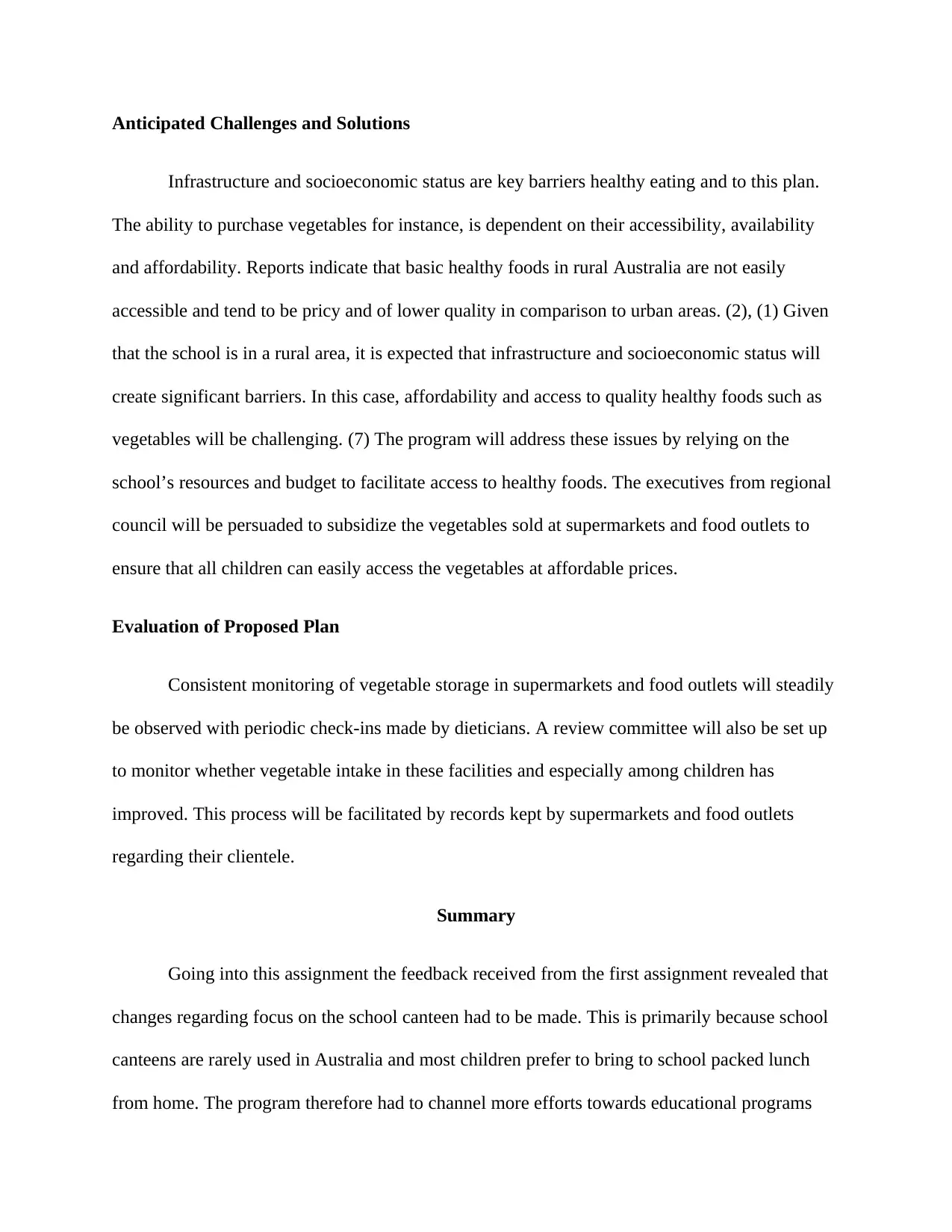
Anticipated Challenges and Solutions
Infrastructure and socioeconomic status are key barriers healthy eating and to this plan.
The ability to purchase vegetables for instance, is dependent on their accessibility, availability
and affordability. Reports indicate that basic healthy foods in rural Australia are not easily
accessible and tend to be pricy and of lower quality in comparison to urban areas. (2), (1) Given
that the school is in a rural area, it is expected that infrastructure and socioeconomic status will
create significant barriers. In this case, affordability and access to quality healthy foods such as
vegetables will be challenging. (7) The program will address these issues by relying on the
school’s resources and budget to facilitate access to healthy foods. The executives from regional
council will be persuaded to subsidize the vegetables sold at supermarkets and food outlets to
ensure that all children can easily access the vegetables at affordable prices.
Evaluation of Proposed Plan
Consistent monitoring of vegetable storage in supermarkets and food outlets will steadily
be observed with periodic check-ins made by dieticians. A review committee will also be set up
to monitor whether vegetable intake in these facilities and especially among children has
improved. This process will be facilitated by records kept by supermarkets and food outlets
regarding their clientele.
Summary
Going into this assignment the feedback received from the first assignment revealed that
changes regarding focus on the school canteen had to be made. This is primarily because school
canteens are rarely used in Australia and most children prefer to bring to school packed lunch
from home. The program therefore had to channel more efforts towards educational programs
Infrastructure and socioeconomic status are key barriers healthy eating and to this plan.
The ability to purchase vegetables for instance, is dependent on their accessibility, availability
and affordability. Reports indicate that basic healthy foods in rural Australia are not easily
accessible and tend to be pricy and of lower quality in comparison to urban areas. (2), (1) Given
that the school is in a rural area, it is expected that infrastructure and socioeconomic status will
create significant barriers. In this case, affordability and access to quality healthy foods such as
vegetables will be challenging. (7) The program will address these issues by relying on the
school’s resources and budget to facilitate access to healthy foods. The executives from regional
council will be persuaded to subsidize the vegetables sold at supermarkets and food outlets to
ensure that all children can easily access the vegetables at affordable prices.
Evaluation of Proposed Plan
Consistent monitoring of vegetable storage in supermarkets and food outlets will steadily
be observed with periodic check-ins made by dieticians. A review committee will also be set up
to monitor whether vegetable intake in these facilities and especially among children has
improved. This process will be facilitated by records kept by supermarkets and food outlets
regarding their clientele.
Summary
Going into this assignment the feedback received from the first assignment revealed that
changes regarding focus on the school canteen had to be made. This is primarily because school
canteens are rarely used in Australia and most children prefer to bring to school packed lunch
from home. The program therefore had to channel more efforts towards educational programs
Paraphrase This Document
Need a fresh take? Get an instant paraphrase of this document with our AI Paraphraser
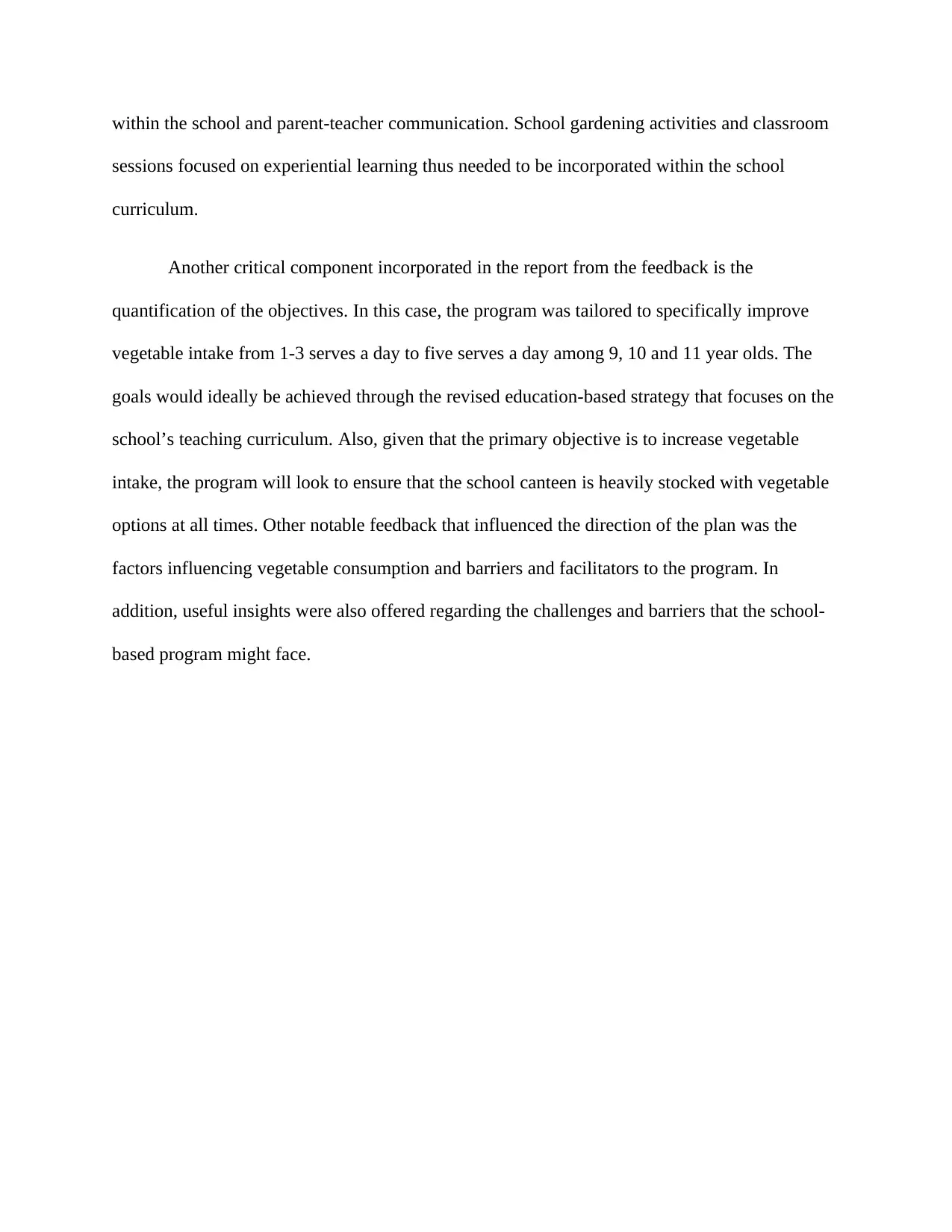
within the school and parent-teacher communication. School gardening activities and classroom
sessions focused on experiential learning thus needed to be incorporated within the school
curriculum.
Another critical component incorporated in the report from the feedback is the
quantification of the objectives. In this case, the program was tailored to specifically improve
vegetable intake from 1-3 serves a day to five serves a day among 9, 10 and 11 year olds. The
goals would ideally be achieved through the revised education-based strategy that focuses on the
school’s teaching curriculum. Also, given that the primary objective is to increase vegetable
intake, the program will look to ensure that the school canteen is heavily stocked with vegetable
options at all times. Other notable feedback that influenced the direction of the plan was the
factors influencing vegetable consumption and barriers and facilitators to the program. In
addition, useful insights were also offered regarding the challenges and barriers that the school-
based program might face.
sessions focused on experiential learning thus needed to be incorporated within the school
curriculum.
Another critical component incorporated in the report from the feedback is the
quantification of the objectives. In this case, the program was tailored to specifically improve
vegetable intake from 1-3 serves a day to five serves a day among 9, 10 and 11 year olds. The
goals would ideally be achieved through the revised education-based strategy that focuses on the
school’s teaching curriculum. Also, given that the primary objective is to increase vegetable
intake, the program will look to ensure that the school canteen is heavily stocked with vegetable
options at all times. Other notable feedback that influenced the direction of the plan was the
factors influencing vegetable consumption and barriers and facilitators to the program. In
addition, useful insights were also offered regarding the challenges and barriers that the school-
based program might face.
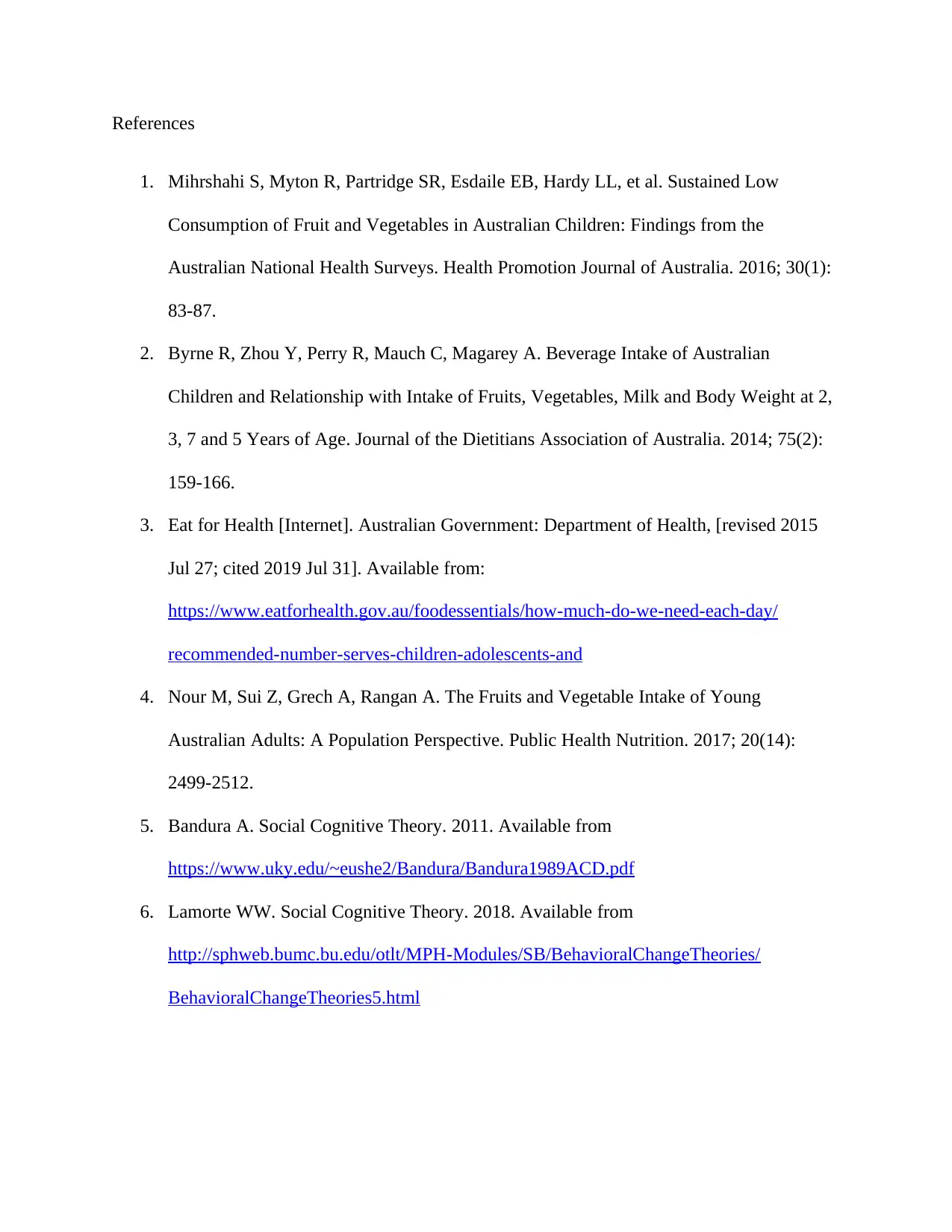
References
1. Mihrshahi S, Myton R, Partridge SR, Esdaile EB, Hardy LL, et al. Sustained Low
Consumption of Fruit and Vegetables in Australian Children: Findings from the
Australian National Health Surveys. Health Promotion Journal of Australia. 2016; 30(1):
83-87.
2. Byrne R, Zhou Y, Perry R, Mauch C, Magarey A. Beverage Intake of Australian
Children and Relationship with Intake of Fruits, Vegetables, Milk and Body Weight at 2,
3, 7 and 5 Years of Age. Journal of the Dietitians Association of Australia. 2014; 75(2):
159-166.
3. Eat for Health [Internet]. Australian Government: Department of Health, [revised 2015
Jul 27; cited 2019 Jul 31]. Available from:
https://www.eatforhealth.gov.au/foodessentials/how-much-do-we-need-each-day/
recommended-number-serves-children-adolescents-and
4. Nour M, Sui Z, Grech A, Rangan A. The Fruits and Vegetable Intake of Young
Australian Adults: A Population Perspective. Public Health Nutrition. 2017; 20(14):
2499-2512.
5. Bandura A. Social Cognitive Theory. 2011. Available from
https://www.uky.edu/~eushe2/Bandura/Bandura1989ACD.pdf
6. Lamorte WW. Social Cognitive Theory. 2018. Available from
http://sphweb.bumc.bu.edu/otlt/MPH-Modules/SB/BehavioralChangeTheories/
BehavioralChangeTheories5.html
1. Mihrshahi S, Myton R, Partridge SR, Esdaile EB, Hardy LL, et al. Sustained Low
Consumption of Fruit and Vegetables in Australian Children: Findings from the
Australian National Health Surveys. Health Promotion Journal of Australia. 2016; 30(1):
83-87.
2. Byrne R, Zhou Y, Perry R, Mauch C, Magarey A. Beverage Intake of Australian
Children and Relationship with Intake of Fruits, Vegetables, Milk and Body Weight at 2,
3, 7 and 5 Years of Age. Journal of the Dietitians Association of Australia. 2014; 75(2):
159-166.
3. Eat for Health [Internet]. Australian Government: Department of Health, [revised 2015
Jul 27; cited 2019 Jul 31]. Available from:
https://www.eatforhealth.gov.au/foodessentials/how-much-do-we-need-each-day/
recommended-number-serves-children-adolescents-and
4. Nour M, Sui Z, Grech A, Rangan A. The Fruits and Vegetable Intake of Young
Australian Adults: A Population Perspective. Public Health Nutrition. 2017; 20(14):
2499-2512.
5. Bandura A. Social Cognitive Theory. 2011. Available from
https://www.uky.edu/~eushe2/Bandura/Bandura1989ACD.pdf
6. Lamorte WW. Social Cognitive Theory. 2018. Available from
http://sphweb.bumc.bu.edu/otlt/MPH-Modules/SB/BehavioralChangeTheories/
BehavioralChangeTheories5.html
⊘ This is a preview!⊘
Do you want full access?
Subscribe today to unlock all pages.

Trusted by 1+ million students worldwide
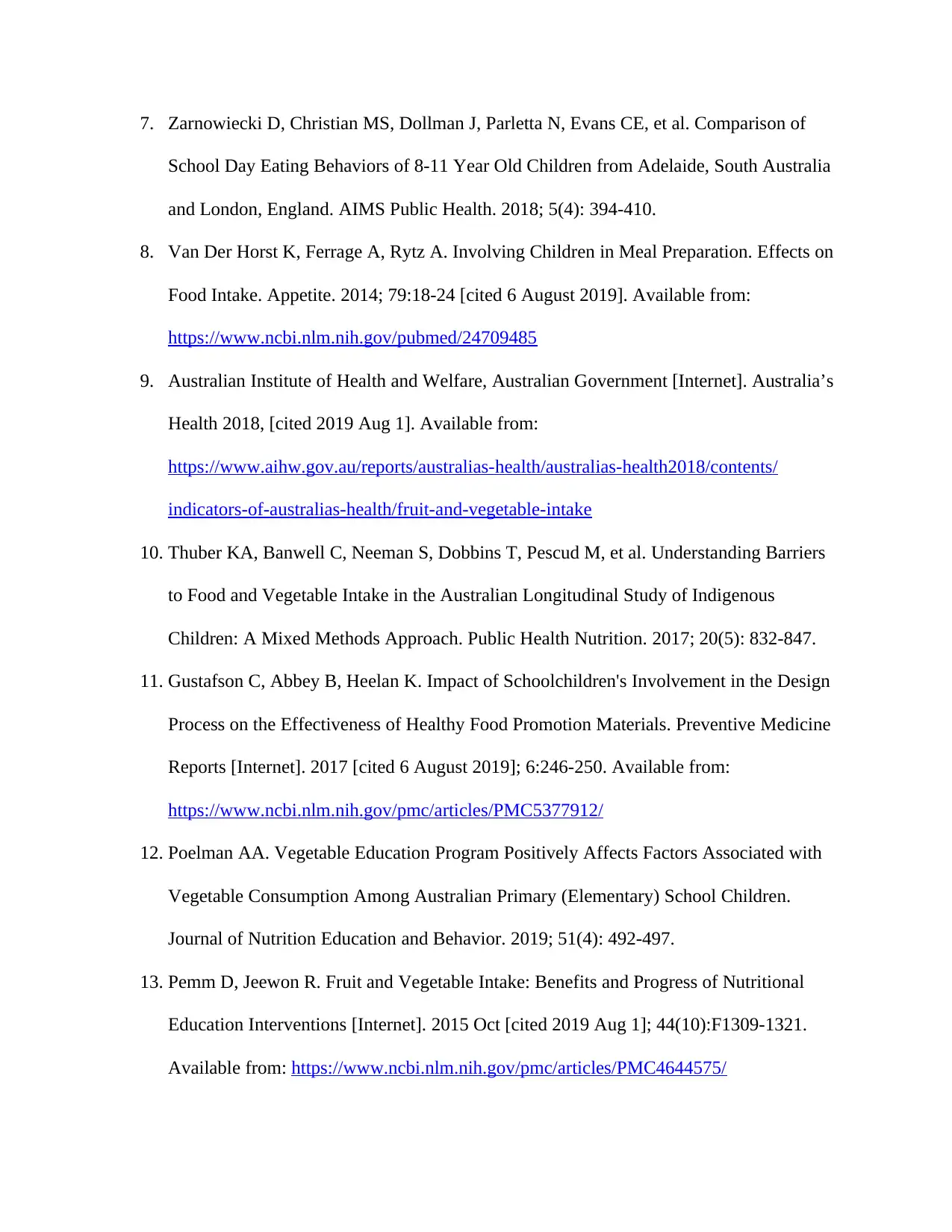
7. Zarnowiecki D, Christian MS, Dollman J, Parletta N, Evans CE, et al. Comparison of
School Day Eating Behaviors of 8-11 Year Old Children from Adelaide, South Australia
and London, England. AIMS Public Health. 2018; 5(4): 394-410.
8. Van Der Horst K, Ferrage A, Rytz A. Involving Children in Meal Preparation. Effects on
Food Intake. Appetite. 2014; 79:18-24 [cited 6 August 2019]. Available from:
https://www.ncbi.nlm.nih.gov/pubmed/24709485
9. Australian Institute of Health and Welfare, Australian Government [Internet]. Australia’s
Health 2018, [cited 2019 Aug 1]. Available from:
https://www.aihw.gov.au/reports/australias-health/australias-health2018/contents/
indicators-of-australias-health/fruit-and-vegetable-intake
10. Thuber KA, Banwell C, Neeman S, Dobbins T, Pescud M, et al. Understanding Barriers
to Food and Vegetable Intake in the Australian Longitudinal Study of Indigenous
Children: A Mixed Methods Approach. Public Health Nutrition. 2017; 20(5): 832-847.
11. Gustafson C, Abbey B, Heelan K. Impact of Schoolchildren's Involvement in the Design
Process on the Effectiveness of Healthy Food Promotion Materials. Preventive Medicine
Reports [Internet]. 2017 [cited 6 August 2019]; 6:246-250. Available from:
https://www.ncbi.nlm.nih.gov/pmc/articles/PMC5377912/
12. Poelman AA. Vegetable Education Program Positively Affects Factors Associated with
Vegetable Consumption Among Australian Primary (Elementary) School Children.
Journal of Nutrition Education and Behavior. 2019; 51(4): 492-497.
13. Pemm D, Jeewon R. Fruit and Vegetable Intake: Benefits and Progress of Nutritional
Education Interventions [Internet]. 2015 Oct [cited 2019 Aug 1]; 44(10):F1309-1321.
Available from: https://www.ncbi.nlm.nih.gov/pmc/articles/PMC4644575/
School Day Eating Behaviors of 8-11 Year Old Children from Adelaide, South Australia
and London, England. AIMS Public Health. 2018; 5(4): 394-410.
8. Van Der Horst K, Ferrage A, Rytz A. Involving Children in Meal Preparation. Effects on
Food Intake. Appetite. 2014; 79:18-24 [cited 6 August 2019]. Available from:
https://www.ncbi.nlm.nih.gov/pubmed/24709485
9. Australian Institute of Health and Welfare, Australian Government [Internet]. Australia’s
Health 2018, [cited 2019 Aug 1]. Available from:
https://www.aihw.gov.au/reports/australias-health/australias-health2018/contents/
indicators-of-australias-health/fruit-and-vegetable-intake
10. Thuber KA, Banwell C, Neeman S, Dobbins T, Pescud M, et al. Understanding Barriers
to Food and Vegetable Intake in the Australian Longitudinal Study of Indigenous
Children: A Mixed Methods Approach. Public Health Nutrition. 2017; 20(5): 832-847.
11. Gustafson C, Abbey B, Heelan K. Impact of Schoolchildren's Involvement in the Design
Process on the Effectiveness of Healthy Food Promotion Materials. Preventive Medicine
Reports [Internet]. 2017 [cited 6 August 2019]; 6:246-250. Available from:
https://www.ncbi.nlm.nih.gov/pmc/articles/PMC5377912/
12. Poelman AA. Vegetable Education Program Positively Affects Factors Associated with
Vegetable Consumption Among Australian Primary (Elementary) School Children.
Journal of Nutrition Education and Behavior. 2019; 51(4): 492-497.
13. Pemm D, Jeewon R. Fruit and Vegetable Intake: Benefits and Progress of Nutritional
Education Interventions [Internet]. 2015 Oct [cited 2019 Aug 1]; 44(10):F1309-1321.
Available from: https://www.ncbi.nlm.nih.gov/pmc/articles/PMC4644575/
Paraphrase This Document
Need a fresh take? Get an instant paraphrase of this document with our AI Paraphraser
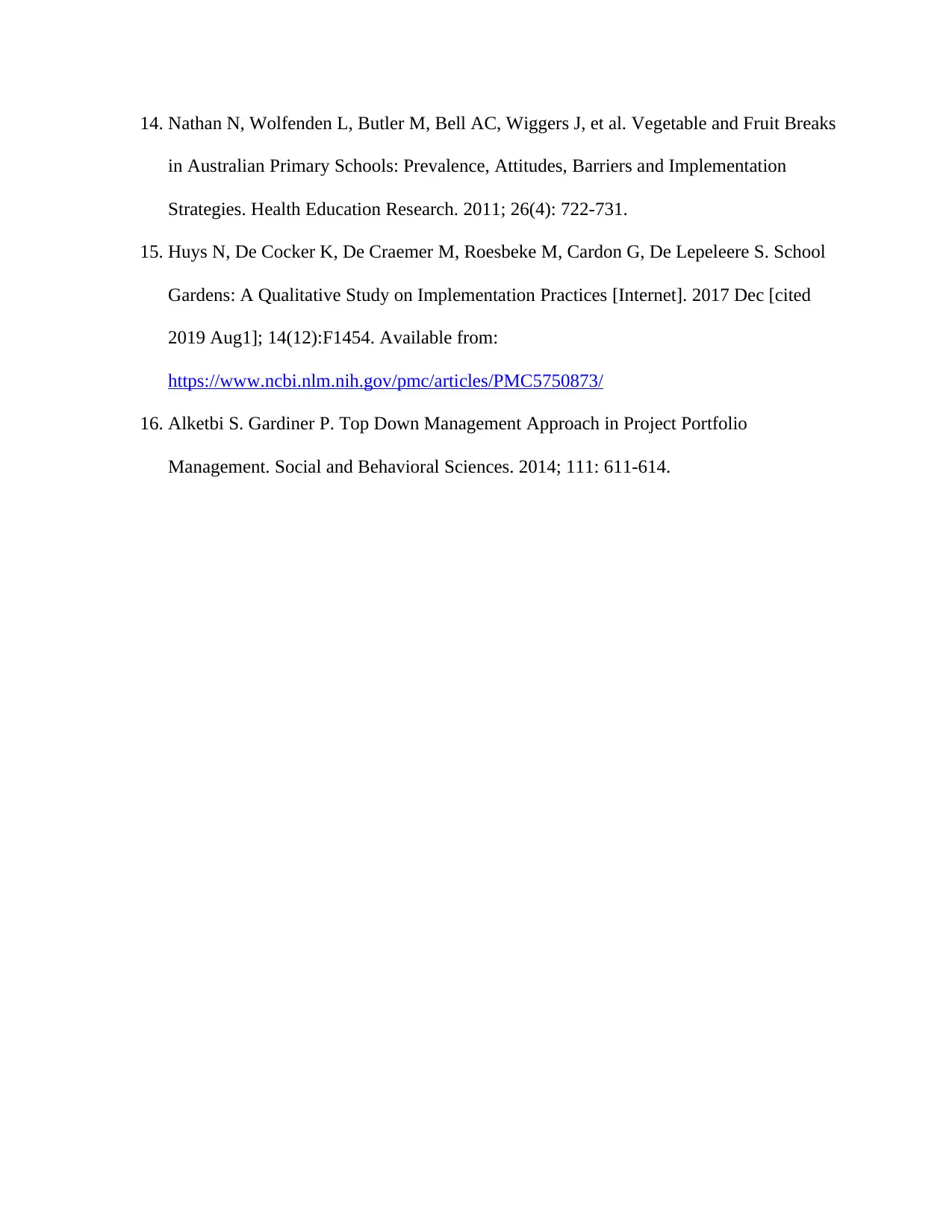
14. Nathan N, Wolfenden L, Butler M, Bell AC, Wiggers J, et al. Vegetable and Fruit Breaks
in Australian Primary Schools: Prevalence, Attitudes, Barriers and Implementation
Strategies. Health Education Research. 2011; 26(4): 722-731.
15. Huys N, De Cocker K, De Craemer M, Roesbeke M, Cardon G, De Lepeleere S. School
Gardens: A Qualitative Study on Implementation Practices [Internet]. 2017 Dec [cited
2019 Aug1]; 14(12):F1454. Available from:
https://www.ncbi.nlm.nih.gov/pmc/articles/PMC5750873/
16. Alketbi S. Gardiner P. Top Down Management Approach in Project Portfolio
Management. Social and Behavioral Sciences. 2014; 111: 611-614.
in Australian Primary Schools: Prevalence, Attitudes, Barriers and Implementation
Strategies. Health Education Research. 2011; 26(4): 722-731.
15. Huys N, De Cocker K, De Craemer M, Roesbeke M, Cardon G, De Lepeleere S. School
Gardens: A Qualitative Study on Implementation Practices [Internet]. 2017 Dec [cited
2019 Aug1]; 14(12):F1454. Available from:
https://www.ncbi.nlm.nih.gov/pmc/articles/PMC5750873/
16. Alketbi S. Gardiner P. Top Down Management Approach in Project Portfolio
Management. Social and Behavioral Sciences. 2014; 111: 611-614.
1 out of 11
Related Documents
Your All-in-One AI-Powered Toolkit for Academic Success.
+13062052269
info@desklib.com
Available 24*7 on WhatsApp / Email
![[object Object]](/_next/static/media/star-bottom.7253800d.svg)
Unlock your academic potential
Copyright © 2020–2025 A2Z Services. All Rights Reserved. Developed and managed by ZUCOL.




